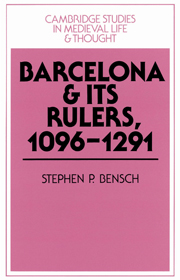Book contents
- Frontmatter
- Contents
- List of figures
- List of maps
- List of tables
- Preface
- List of abbreviations
- Introduction
- 1 The city and its region
- 2 The city and its lord
- 3 An aborted take-off: the urban economy in crisis, 1090–1140
- 4 Urban society in transition
- 5 The patriciate in gestation, 1140–1220
- 6 Family structure and the devolution of property
- 7 Consolidation and conflict: patrician power and Mediterranean expansion, 1220–1291
- 8 Patrician continuity and family identity
- Conclusion
- Appendix 1 Vicars of Barcelona
- Appendix 2 Bailiffs of Barcelona
- Appendix 3 Coinages and exchange values
- Appendix 4 Select documents
- Appendix 5 Select genealogies
- Bibliography
- Index
- Cambridge studies in medieval life and thought
8 - Patrician continuity and family identity
Published online by Cambridge University Press: 08 December 2009
- Frontmatter
- Contents
- List of figures
- List of maps
- List of tables
- Preface
- List of abbreviations
- Introduction
- 1 The city and its region
- 2 The city and its lord
- 3 An aborted take-off: the urban economy in crisis, 1090–1140
- 4 Urban society in transition
- 5 The patriciate in gestation, 1140–1220
- 6 Family structure and the devolution of property
- 7 Consolidation and conflict: patrician power and Mediterranean expansion, 1220–1291
- 8 Patrician continuity and family identity
- Conclusion
- Appendix 1 Vicars of Barcelona
- Appendix 2 Bailiffs of Barcelona
- Appendix 3 Coinages and exchange values
- Appendix 4 Select documents
- Appendix 5 Select genealogies
- Bibliography
- Index
- Cambridge studies in medieval life and thought
Summary
The character of Barcelona's patriciate can not be explained solely in terms of wealth and the exercise of power. Even if detailed tax registers had survived to reveal the precise amount of income and property every burgher possessed and municipal and royal rolls listed every bailiff, town councillor, revenue farmer, and mill owner, this would not in fact significantly sharpen the resolution on the silhouette of the patriciate projected in the preceding chapters. The humbler ranks of the urban population did not recognize the city's distinguished citizens by reviewing their tax returns or scrutinizing their diplomas, laborious tasks whose relevance mercifully remains a trade secret of modern investigators. Artisans, petty merchants, and laborers came to identify and associate patricians with certain family names, the circle of individuals whom they could marry, the churches and charitable institutions they supported, and a type of public display and comportment that gave them a mark of distinction. Only through the perpetuation of a cultural style and a family identity could the patriciate as a group retain its coherence as individual parentelae joined it and established houses became extinct.
Not until the patriciate began to take shape after the mid-twelfth century did a distinctively bourgeois culture assert its character and independence in Barcelona. Previously wealthy, influential families connected with the town had largely shared the aspirations of the provincial nobility, which itself had close relationships with Barcelona and its lords.
- Type
- Chapter
- Information
- Barcelona and its Rulers, 1096–1291 , pp. 347 - 393Publisher: Cambridge University PressPrint publication year: 1995



